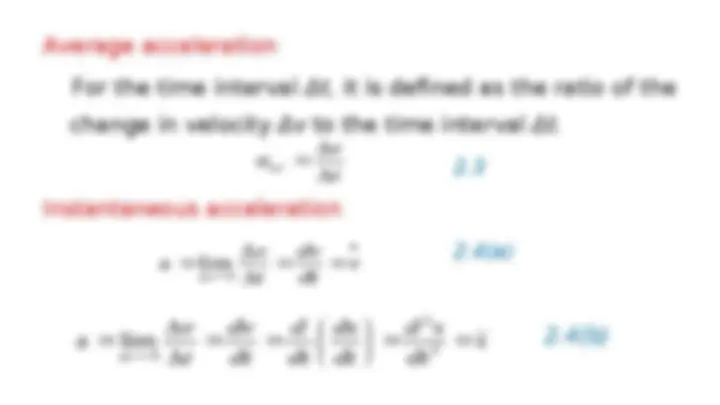Download enginerring dynamics and more Lecture notes Dynamics in PDF only on Docsity!
School of Mechanical
and Industrial
Engineering
Chapter Two
Kinematics of Particles
Introduction
Kinematics: is the branch of dynamics which
describes the motion of bodies without reference
to the forces that either causes the motion or
are generated as a result of the motion.
Kinematics is often referred to as the “geometry
of motion”
- (^) If the particle is confined to a specified path , as with a bead sliding along a fixed wire, its motion is said to be Constrained. Example 1. - A small rock tied to the end of a string and whirled in a circle undergoes constrained motion until the string breaks
- (^) If there are no physical guides, the motion is said to be unconstrained. Example 2. - Airplane, rocket
- (^) The motion of particles(or rigid bodies) may be
described by using coordinates measured from
fixed reference axis (absolute motion analysis)
or by using coordinates measured from
moving reference axis (relative motion
analysis).
Rectilinear motion
- (^) Is a motion in which a particle moving along a straight line(one-dimensional motion)
- (^) Consider a particle P moving along a straight line.
Average acceleration For the time interval Δt, it is defined as the ratio of the change in velocity Δv to the time interval Δt. 2. Instantaneous acceleration 2.4(a) 2.4(b) t v aav v dt dv t v t 0 a lim s dt d s dt ds dt d dt dv t v t ^ 2 2 0 a lim
- (^) Note:-The acceleration is positive or negative depending on whether the velocity increasing or decreasing.
- (^) Considering equation 2.2 and 2.4(a) , we have s d s s ds s d s s ds dt vdv ads a dv v ds dt
- Graph of s Vs t
- (^) By constructing tangent to the curve at any time
t, we obtain the slope, which is the velocity v=ds/
dt
- Graph of v Vs t
- (^) The slope dv/dt of the v-t curve at any instant gives the acceleration at that instant.
- The area under the v-t curve during time dt is vdt which is the displacement ds
- Graph of a vs t
- (^) The area under the a-t curve during time dt is the net change in velocity of the particle between t 1 and t2. v 2 - v 1 =(area under a-t curve)
2 1 2 1 v v t t
dv adt
- Graph of a Vs s
- (^) The net area under the curve b/n position coordinates s 1 and s 2 is (areas under a-s curve)
2 1 2 1 v v s s
vdv ads
1 2 2
v v
- (^) The graphical representations described are useful for:- (^) visualizing the relationships among the several motion quantities. (^) approximating results by graphical integration or differentiation when a lack of knowledge of the mathematical relationship prevents its expression as an explicit mathematical function. (^) experimental data and motions that involve discontinuous relationship b/n variables.
Methods for determining the velocity and displacement functions
































































































































































































